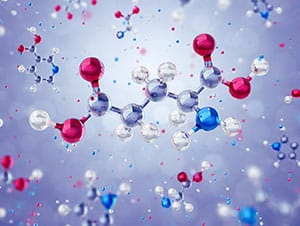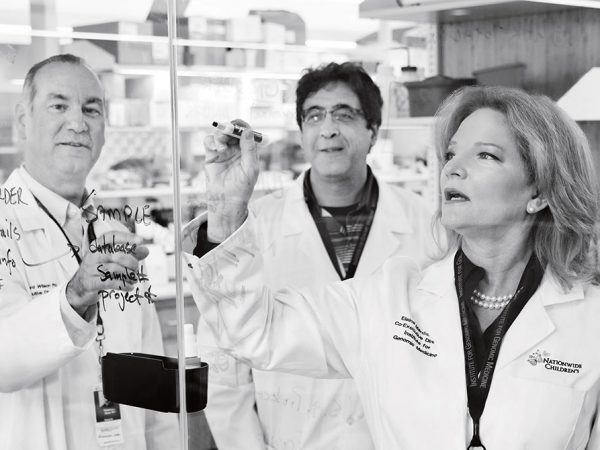How Do Cancers Hijack Cellular Metabolism?
You’re feeling sluggish. You eat a banana. You feel better.
We all know that a calorie-rich snack can provide a much-needed energy boost during those afternoon doldrums, but how do we go from point A (eating) to point B (having energy)?
That’s where cellular metabolism comes in. This system of processes converts the sugars we ingest through food into energy that our cells can use to carry out their many functions, including protein production, waste management, and cellular replication.
Cancer cells need energy, too, and they produce it by co-opting the same metabolic processes that normal healthy cells use. Cancerous hijacking of cellular metabolism is so common that it was deemed one of the hallmarks of cancer in the 2011 version of an influential review by AACR Fellows Robert Weinberg, PhD, and Douglas Hanahan, PhD. The latest iteration of the cancer hallmarks was published earlier this year in the AACR journal Cancer Discovery and summarized in a blog post.
There are many ways in which cancers manipulate cellular metabolism. One, identified in 1927 by Otto Warburg, is by pushing cancer cells to anaerobic fermentation, a process that normally occurs only in the absence of oxygen, but which cancer cells undergo even in the presence of sufficient oxygen. This phenomenon, now dubbed the Warburg effect, allows cancer cells to quickly generate proteins, DNA, and other cellular components to aid their rapid proliferation.
Intriguingly, genes encoding metabolic enzymes are seldom mutated in cancers, likely due to the lethality such mutations could pose. Instead, metabolic pathways are manipulated as a result of mutations in upstream proteins, many of which represent the most commonly mutated proteins in cancer. Oncogenic mutations of the MYC transcription factor and various proteins within the PI3K-mTOR and KRAS signaling pathways, for instance, affect the downstream expression of key metabolic enzymes. Mutant KRAS also promotes the expression of cell surface receptors that respond to external stimuli, and it upregulates mechanisms that allow cells to recycle metabolites. Loss of p53 function, common in cancers, leads to increased glycolysis and anabolic metabolism.
Given the prevalence of mutations in these proteins, several of them are common targets of cancer therapies. Inhibitors of PI3K, mTOR, and KRAS are clinically available, and efforts to target p53 and MYC are ongoing. Blocking the activity of these key enzymes not only impacts the cell proliferative pathways they regulate but may also modulate downstream metabolic signaling.
Metabolic adaptations may allow cancers to evade antitumor immune responses
In addition to boosting a tumor’s energy-producing capabilities, co-opting cellular metabolism may allow cancers to circumvent the antitumor immune response. Recent studies reveal the intricate relationship between cellular metabolism and immune activity in cancer.
Mitochondria marauders: Robbing immune cells of their powerhouse
As the sites of key metabolic processes, mitochondria provide the energy cells need to survive and replicate. So important are these tiny, kidney bean-shaped organelles that some cancers have developed ways to physically steal them from normal immune cells, according to a recent study in Nature Nanotechnology. This may allow cancer cells both to power themselves and to evade antitumor responses by draining immune cells of their energy sources.
In the study, researchers used microscopy to visualize fluorescently labeled mitochondria in a co-culture of cancer cells and immune cells. They observed the formation of nanoscale tube-like structures, referred to as nanotubes, between cancer and immune cells and the unidirectional transfer of labeled mitochondria from immune cells to cancer cells. As a result of mitochondrial gain, cancer cells from the co-culture assay exhibited higher metabolic activity than control cells, which translated to increased cellular proliferation. In contrast, immune cells that experienced mitochondrial loss had significantly reduced metabolic activity.
Pharmacologic inhibition of nanotube formation and mitochondrial trafficking suppressed tumor growth and increased the number and activation of cytotoxic immune cells in preclinical tumor models. Combined blockade of mitochondrial trafficking and immune checkpoints led to greater antitumor effects than either inhibitor alone, revealing inhibition of mitochondrial hijacking as a potential strategy to boost responses to immunotherapy.
The effect of diet on antitumor immunity
Metabolic adaptations to diet can also impact antitumor immunity. In a recent study published in Cell, researchers found that metabolic changes in response to a high fat diet promoted tumor growth but impaired T-cell function in mice. Specifically, high fat diet-induced obesity caused tumor cells to upregulate pathways that utilize free fatty acids, thereby depleting the tumor microenvironment, and the T cells within it, of this key energy source. Blocking this metabolic reprogramming in tumor cells increased the free fatty acids in the tumor microenvironment and facilitated T-cell activation and antitumor immune activity, suggesting that interventions that modulate metabolic activity could be an approach to enhance the efficacy of cancer immunotherapies in patients with obesity.

In another study, published earlier this year in Cancer Research, researchers explored the impact of ketogenic diet—diet that is high in fat and low in carbohydrates—on immune responses to colorectal cancer. They observed that colorectal cancers commonly had low activation of ketogenesis, a metabolic pathway that breaks down fats to generate ketone bodies as a source of energy. The lower activation of ketogenesis in colorectal cancers limited antitumor immunity by upregulating the immune-suppressing protein CXCL12. When mice were fed ketogenic diets, ketogenesis was restored in colorectal tumor cells, CXCL12 production was decreased, and antitumor immune cells infiltrated tumors. Furthermore, the ketogenic diet enhanced immune checkpoint inhibition in mice and suppressed cancer cell migration, invasion, and metastasis. Together, the results highlight the uptake of a ketogenic diet as a potential metabolic strategy to overcome immune suppression in colorectal cancer.
Dysregulation of metabolism introduces therapeutic opportunities
A complex network of metabolic signaling allows our cells to generate energy to fuel their many functions. Not surprisingly, these vital pathways are dysregulated in cancer cells to favor tumor growth and disease progression. Ironically, the very strategies that cancers use to co-opt metabolism for their benefit may make them vulnerable to therapeutic intervention.
In one example, published in the AACR journal Cancer Research, researchers identified a potentially actionable metabolic vulnerability in MYC-mutated malignancies. The researchers observed that mutant MYC repressed TFEB, a master regulator of the tumor-suppressing, cellular recycling autophagy pathway that is activated when energy sources are limited. This allowed cancer cells to avoid autophagy even in the face of a nutrient-poor microenvironment. However, this strategy came at a cost: Turning off autophagy increased the tumor’s dependence on alternative metabolic mechanisms to generate amino acids, molecular building blocks necessary for cellular functions. The authors propose these alternative mechanisms as metabolic vulnerabilities that could be therapeutically targeted by existing inhibitors.

Another metabolic target was identified in a study published in the AACR journal Blood Cancer Discovery and presented at the AACR Annual Meeting 2021. Here, researchers identified the metabolism-regulating protein SIRT5 as essential to the survival of acute myeloid leukemia cells. Genetic depletion of SIRT5 impacted several metabolic pathways, reduced cell proliferation, and promoted death in leukemia cells, but not in normal cells. Similar findings were observed when SIRT5 activity was inhibited by NRD167, a selective SIRT5 inhibitor developed by the researchers.
A publication in Cancer Discovery revealed how some modern cancer therapies introduce metabolic vulnerabilities that could be targeted to enhance the efficacy of these treatments. The authors found that cancer therapies targeting epigenetic elements reactivated retroelements in genomic DNA, inducing cellular responses that depleted intracellular energy. Energy depletion by these epigenetic modulators led cells to switch from utilizing glycolysis to using mitochondrial oxidative phosphorylation to produce energy. By turning off glycolysis, the cancers effectively reversed the Warburg effect, thereby limiting their ability to rapidly generate proteins, DNA, and other critical molecules. The researchers also determined that cells treated with these epigenetic modulators were increasingly dependent on the BCL2 protein to prevent cell death. Therefore, they proposed combining epigenetic therapies with BCL2-targeted drugs to enhance the cell-killing capabilities of these treatments, an idea supported by experiments in cell culture models of multiple tumor types. This study demonstrated how metabolic adaptations to cancer therapies can provide potential therapeutic opportunities.
Together, these studies highlight the myriad ways that cancers modify metabolic processes, as well as how they adapt to metabolic changes caused by external factors. Researchers continue to study how cancers hijack cellular metabolism, with the ultimate goal of identifying novel strategies to disrupt disease onset and progression.



